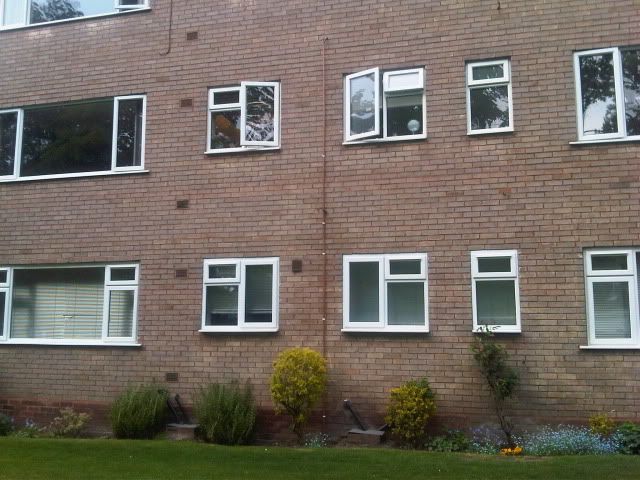My bro lives in the flat pictured below, he lives on the middle floor. The 5 windows you see on the middle floor are all his.
This random vertical copper pipe has appeared from the flat above running vertically in between my bro's bathroom and kitchen window. At the bottom it's just open ended a few inches off the ground.
I have no idea about plumbing but i'm guessing some sort of overflow or condensate pipe.
The thing is, it looks kind of ugly, there are no other copper pipes anywhere, just discreet plastic overflow pipes, airbricks and shower vents. I know some of you may be thinking just live with it, but my bro paid over the odds for this flat as they are in an affluent area with landscaped gardens etc and it just seems to spoil the building. It doesn't help either that no compo has been put into the hole at the top where the pipe comes out of the wall (you can't see on the photo but there is a good 2 inches around where the pipe comes out). It also looks like the pipe is coming from my bro's ceiling rather than the flat above.

Can someone tell me what it is for? And why couldn't it be discharged into an internal waste pipe?
My bro was going to mention it to the people above who he gets on with and are really nice people but I thought i'd check on here first so that if nothing can be done and it's all correct, he won't have to bother them.
Ta
This random vertical copper pipe has appeared from the flat above running vertically in between my bro's bathroom and kitchen window. At the bottom it's just open ended a few inches off the ground.
I have no idea about plumbing but i'm guessing some sort of overflow or condensate pipe.
The thing is, it looks kind of ugly, there are no other copper pipes anywhere, just discreet plastic overflow pipes, airbricks and shower vents. I know some of you may be thinking just live with it, but my bro paid over the odds for this flat as they are in an affluent area with landscaped gardens etc and it just seems to spoil the building. It doesn't help either that no compo has been put into the hole at the top where the pipe comes out of the wall (you can't see on the photo but there is a good 2 inches around where the pipe comes out). It also looks like the pipe is coming from my bro's ceiling rather than the flat above.

Can someone tell me what it is for? And why couldn't it be discharged into an internal waste pipe?
My bro was going to mention it to the people above who he gets on with and are really nice people but I thought i'd check on here first so that if nothing can be done and it's all correct, he won't have to bother them.
Ta

